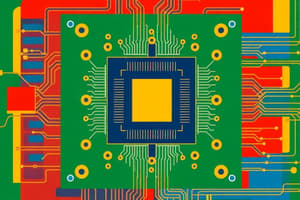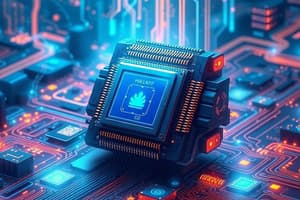Podcast
Questions and Answers
What is the main difference between the Von Neumann and Harvard architectures?
What is the main difference between the Von Neumann and Harvard architectures?
- The size of the main memory
- The type of instructions used in the CPU
- The number of registers in the CPU
- The number of buses used to transfer data and instructions (correct)
What is the primary objective of Strategic Cost Management?
What is the primary objective of Strategic Cost Management?
- To improve the strategic position of the firm without considering cost reduction
- To reduce costs without considering the strategic position of the firm
- To simultaneously improve the strategic position of a firm and reduce costs (correct)
- To focus only on cost reduction without considering the firm's strategic objectives
What is the role of a Management Accountant in Strategic Cost Management?
What is the role of a Management Accountant in Strategic Cost Management?
- To provide cost information to support strategic decision-making (correct)
- To focus solely on cost control and reduction
- To only analyze financial statements
- To manage the firm's financial resources
Which of the following is NOT a pillar of Strategic Cost Management?
Which of the following is NOT a pillar of Strategic Cost Management?
How does Strategic Cost Management differ from traditional Cost Accounting?
How does Strategic Cost Management differ from traditional Cost Accounting?
What is the difference between Cost Control and Cost Reduction?
What is the difference between Cost Control and Cost Reduction?
Which of the following is a benefit of aligning costs with business strategy?
Which of the following is a benefit of aligning costs with business strategy?
What is the role of Information Technology in Strategic Cost Management?
What is the role of Information Technology in Strategic Cost Management?
What is the primary focus of Strategic Cost Management?
What is the primary focus of Strategic Cost Management?
What is the primary difference between cost accounting and management accounting?
What is the primary difference between cost accounting and management accounting?
What is the shift in emphasis from cost containment to cost reduction?
What is the shift in emphasis from cost containment to cost reduction?
What is the role of cost management in a contemporary set-up?
What is the role of cost management in a contemporary set-up?
What is the limitation of Ridgway's measurement mantra?
What is the limitation of Ridgway's measurement mantra?
What is the focus of cost management in a contemporary set-up?
What is the focus of cost management in a contemporary set-up?
What is the role of a management accountant in strategic cost management?
What is the role of a management accountant in strategic cost management?
What is a key limitation of traditional cost management?
What is a key limitation of traditional cost management?
What is the primary goal of strategic cost management?
What is the primary goal of strategic cost management?
Why is detailed cost analysis essential in strategic cost management?
Why is detailed cost analysis essential in strategic cost management?
What is the role of a management accountant in strategic cost management?
What is the role of a management accountant in strategic cost management?
What is the primary difference between cost control and cost reduction?
What is the primary difference between cost control and cost reduction?
How does information technology support strategic cost management?
How does information technology support strategic cost management?
What is the outcome of aligning costs with business strategy?
What is the outcome of aligning costs with business strategy?
Why is strategic cost management essential in modern business environments?
Why is strategic cost management essential in modern business environments?
Flashcards are hidden until you start studying
Study Notes
Instruction Set Architecture (ISA)
- Defines the syntax and semantics of a computer's instruction set
- Specifies the format of instructions, registers, and memory access
- Examples: x86, ARM, MIPS
Computer Organization
- Focuses on the way instructions are executed within the CPU
- Includes the design of the CPU, memory, and input/output systems
- Concerned with the flow of data and instructions within the computer
CPU Components
- Control Unit: retrieves and decodes instructions, generates control signals
- Arithmetic Logic Unit (ALU): performs arithmetic and logical operations
- Registers: small amounts of on-chip memory for storing data and instructions
CPU Architectures
- Von Neumann Architecture: uses a single bus to transfer data and instructions between CPU, memory, and I/O devices
- Harvard Architecture: uses separate buses for data and instructions
- RISC (Reduced Instruction Set Computing): uses a simplified instruction set to improve performance
- CISC (Complex Instruction Set Computing): uses a complex instruction set to improve performance
Memory Hierarchy
- Main Memory: large, slow, and inexpensive memory for storing data and programs
- Cache Memory: small, fast, and expensive memory for storing frequently accessed data
- Virtual Memory: uses a combination of main memory and disk storage to provide a larger address space
Input/Output (I/O) Systems
- I/O Devices: keyboards, displays, printers, etc.
- I/O Interfaces: connects I/O devices to the CPU and memory
- I/O Controllers: manages data transfer between I/O devices and the CPU
Parallel Computing
- Multiprocessing: uses multiple CPUs to improve performance
- Multithreading: uses multiple threads to improve performance
- Parallel Processing: uses multiple processing units to improve performance
Performance Metrics
- CPU Utilization: measures the percentage of time the CPU is busy
- Throughput: measures the number of instructions or tasks completed per unit time
- Response Time: measures the time it takes to complete a task or respond to an input
- Benchmarking: measures the performance of a computer using standardized tests
Instruction Set Architecture (ISA)
- Defines syntax and semantics of a computer's instruction set
- Specifies instruction format, registers, and memory access
- Examples of ISAs include x86, ARM, and MIPS
Computer Organization
- Focuses on instruction execution within the CPU
- Covers CPU, memory, and input/output system design
- Concerned with data and instruction flow within the computer
CPU Components
- Control Unit: retrieves and decodes instructions, generates control signals
- Arithmetic Logic Unit (ALU): performs arithmetic and logical operations
- Registers: small on-chip memory for storing data and instructions
CPU Architectures
- Von Neumann Architecture: single bus for data and instruction transfer
- Harvard Architecture: separate buses for data and instructions
- RISC (Reduced Instruction Set Computing): simplified instruction set for improved performance
- CISC (Complex Instruction Set Computing): complex instruction set for improved performance
Memory Hierarchy
- Main Memory: large, slow, and inexpensive memory for data and programs
- Cache Memory: small, fast, and expensive memory for frequently accessed data
- Virtual Memory: combination of main memory and disk storage for a larger address space
Input/Output (I/O) Systems
- I/O Devices: keyboards, displays, printers, etc.
- I/O Interfaces: connects I/O devices to CPU and memory
- I/O Controllers: manages data transfer between I/O devices and CPU
Parallel Computing
- Multiprocessing: multiple CPUs for improved performance
- Multithreading: multiple threads for improved performance
- Parallel Processing: multiple processing units for improved performance
Performance Metrics
- CPU Utilization: percentage of time CPU is busy
- Throughput: number of instructions or tasks completed per unit time
- Response Time: time to complete a task or respond to input
- Benchmarking: measures performance using standardized tests
Strategic Cost Management
- Strategic Cost Management is the use of cost information to develop and deploy strategies for superior performance, leading to sustainable competitive advantage.
- It can be applied in service and manufacturing settings, as well as in not-for-profit environments.
- It deals with the assimilation of both quantitative and qualitative information in decision making.
Pillars of Strategic Cost Management
- Strategic positioning
- Cost driver analysis
- Value chain analysis
Characteristics of Strategic Cost Management
- Managerial use of cost information explicitly directed at one or more of the four stages of strategic management (strategy formulation, communicating the strategy, implementing the strategy, and controlling)
- Recognition of the cost relationships among the activities in the value chain and the process of managing those cost relationships to attain the firm's strategic objectives
- Focus on cost reduction and cost management to gain and sustain a competitive advantage
Limitations of Traditional Cost Management
- Limited focus on review and investigation of quantitative variances and deviations
- Reactive approach, corrective function rather than preventive
- Short-term outlook, focusing on the upcoming year, quarter, or even month
Need for Strategic Cost Management
- Requirement for detailed cost analysis to gain an in-depth understanding of cost structure
- Strategic use of cost data to gain and sustain a competitive advantage
- Need to assimilate cost management into strategy and vice versa
- Need to comprehend the big picture, having a holistic analysis of cost relations among the different activities
Studying That Suits You
Use AI to generate personalized quizzes and flashcards to suit your learning preferences.




